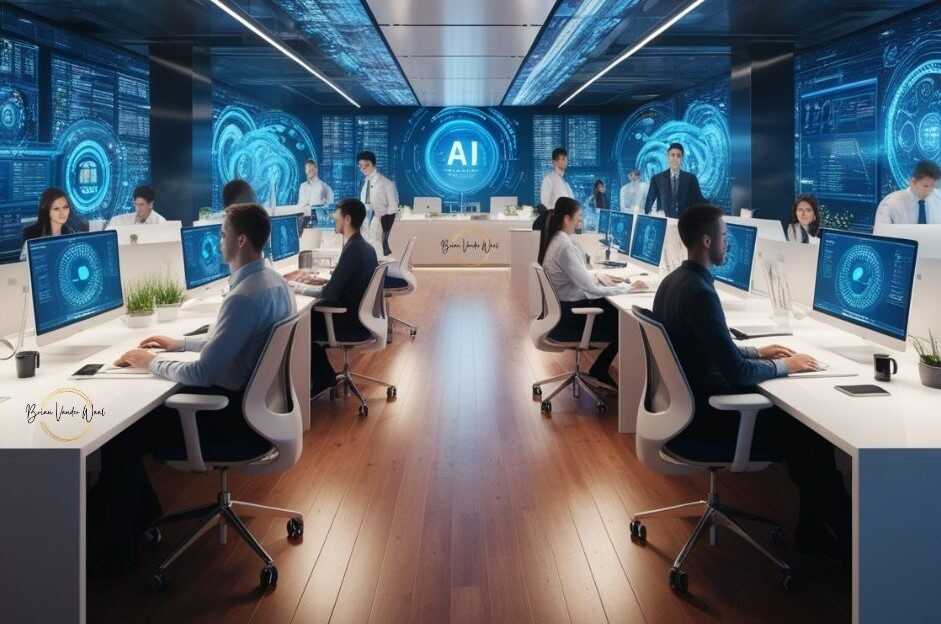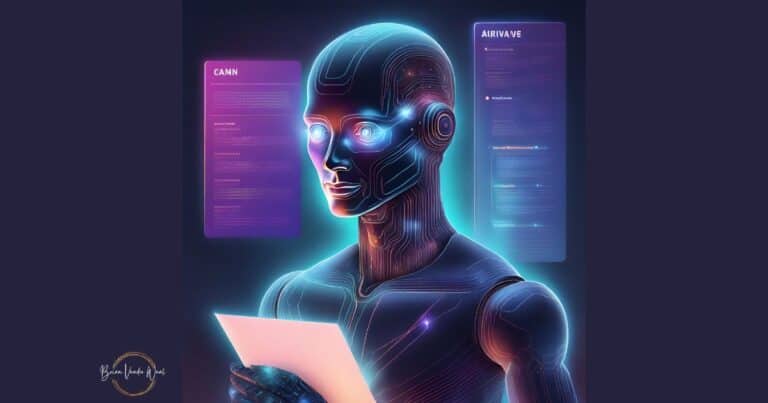The workplace is changing faster than ever. AI is at the heart of this shift, sparking a revolution in how we work. Yet, many still ask, “How is AI revolutionising workplace productivity?” It’s a fair question, given the hype and scepticism surrounding AI.
Here is a story that might shed some light. Maya, a marketing agency CEO, was once a staunch AI sceptic. “We’re creatives,” she’d say, “AI can’t do what we do.” But facing tough competition, she decided to give it a shot.
The results were nothing short of transformative. Within months, Maya’s team’s efficiency soared. The team spent half the time creating reports. Also, the AI-driven analysis yielded insights that rivalled those of seasoned data scientists. The best part? Her creative staff now had more time for strategy and client relationships – the work that truly mattered.
Maya’s experience is not an isolated case. Across industries, AI is boosting productivity in remarkable ways. According to Deloitte’s global “State of AI in the Enterprise” report, 94% of business leaders consider AI essential for success. The same study revealed that more than 60% of business owners believe AI will boost productivity.
But let’s be clear: AI isn’t about replacing humans. It’s about enhancing our abilities, freeing us from mundane tasks to focus on what we do best – think creatively, solve complex problems, and build relationships. AI is a tool that empowers us, not a threat to our roles.
In this article, I will discuss how AI is transforming workplace productivity in 2026. I will look at real-world applications, tackle implementation challenges, and peek at emerging trends.
Whether you’re a business leader or an HR professional, understanding these developments is crucial to staying competitive.
Key Takeaways (TL;DR): How is AI Revolutionizing Workplace Productivity?
- AI is a Powerful Tool for Productivity: Artificial intelligence can analyse data, provide valuable insights, and improve decision-making. It can also automate repetitive tasks and enhance customer satisfaction, freeing employees to focus on more strategic and creative work.
- Start Small and Scale Wisely: Don’t try to implement AI everywhere at once. Begin with a specific area where AI can add the most value and gradually expand its role within your organisation.
- Successful implementation requires a strategic approach: Organisations must consider their goals, culture, and data before integrating AI tools.
- Address Resistance to Change: Be prepared for resistance from employees who may fear job loss. Open communication and training can help alleviate these concerns.
- Prioritise Data Quality: Ensure your data is accurate and reliable through proper data collection, management, and security. High-quality data is essential for AI to provide accurate insights and predictions.
- Consider ethical implications: Implement AI transparently and fairly. When implementing AI solutions, consider ethical concerns such as bias and privacy.
- Invest in training and culture: Equip your team to use AI effectively and cultivate a culture that embraces innovation and change. Keep up with the newest trends and technologies to ensure your organisation remains competitive.
- Human Expertise Remains Essential: While AI can automate many tasks, human expertise is still crucial for strategic thinking, decision-making, creativity, and problem-solving.
- Measure and adjust: Consistently assess the impact of AI on productivity and make adjustments as needed to optimise results.
- Embrace the future: AI is rapidly developing. Keep informed about emerging developments and be ready to adjust your strategies as needed.
Understanding AI and Its Role in the Modern Workplace

What is AI?
I remember when I first started advising companies on AI integration. Many leaders had this deer-in-headlights look when I mentioned artificial intelligence. They’d picture sci-fi robots taking over their offices! But let me break it down for you in plain English.
Artificial intelligence, or AI, refers to computer systems’ simulation of human intelligence processes. These processes include learning, reasoning, and self-correction.
AI is like giving a computer a brain. It’s designed to think and learn, much like we do. But it can do it at speeds we can only dream of.
In other words, AI is like having a team member who can crunch numbers, spot patterns, and even understand human language at superhuman speeds. Better yet, it learns and improves over time.
Further, AI includes a range of innovations, including machine learning, natural language processing and predictive analytics. These technologies enable organisations to automate routine tasks and enhance their workflows.
The Role of AI in the Modern Workplace
By adopting AI tools, organisations can simplify their operations and focus on strategic activities that drive growth.
In many companies, AI is used to:
- Automate repetitive tasks
- Analyse large amounts of data
- Provide insights that facilitate informed decision-making.
The potential of AI in transforming work dynamics cannot be overstated. AI tools empower employees to concentrate on more complex tasks while AI handles the tedious ones.
As a consultant, I’ve seen AI transform businesses in amazing ways.
There was this HR manager I worked with who was drowning in resumes. She’d spend hours sifting through applications to find suitable candidates. Then we implemented an AI-powered recruitment tool, and boom! The system could scan hundreds of resumes in minutes, picking out the most qualified candidates based on the job requirements.
But here’s the cool part. The AI recruitment tool didn’t just look for keywords. It understood context, learned from past successful hires, and even spotted potential in candidates that might have previously been overlooked. As a result, the HR manager went from spending 70% of her time on resume screening to focusing on what she does best – building relationships with top talent.
That’s just one example of how AI is changing the game. From predicting customer behaviour to automating repetitive tasks, AI frees time for employees to focus on creative and strategic work.
Now, I’m not saying AI is perfect. It’s a tool; like any tool, it must be used correctly. But when implemented thoughtfully, it can seriously boost your team’s productivity.
Here’s a pro tip for business leaders:
- Start small.
- Don’t try to overhaul your entire operation overnight.
- Pick one area where your team struggles with efficiency and explore AI solutions. You might be surprised at how quickly you see results.
The goal is to use AI tools to empower your team to do their jobs better and faster. By using AI effectively, businesses can align their strategies to achieve better outcomes and enhance employee productivity.
The Development of AI Technologies Within Workplace Technology
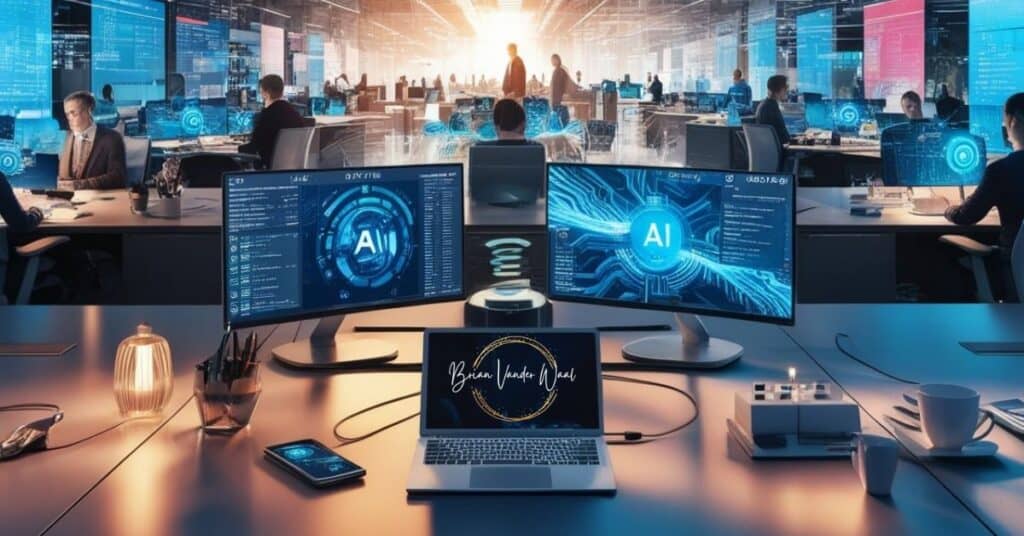
The pace of AI development is mind-boggling. It’s like watching a child grow up but at warp speed.
My Experience in the Development of AI Technology
When I first started advising companies on AI, we were dealing with pretty basic stuff. I remember working with a manufacturing plant implementing a rule-based system to optimise their production line. It was impressive for its time, but looking back, it was like using a flip phone in the age of smartphones.
Fast forward a few years, and I’m helping a financial services firm implement an Artificial Intelligence tool to detect fraud. The system could analyse thousands of transactions in seconds, spotting patterns that would take a human analyst weeks to find. The head of security couldn’t believe his eyes when we ran the first test. “It’s like having a team of super-analysts working 24/7,” he said.
The continuous improvement in AI models changes everything. These systems aren’t static. They’re constantly learning and improving. I have seen AI systems start good and become exceptional over time as they learn from more data.
For business leaders, this rapid development means two things:
First, the potential applications of AI are constantly expanding. What seemed impossible a year ago might be standard practice today.
Second, staying competitive means staying updated. I always tell my clients, “If you’re not leveraging the latest AI tech, you can bet your competitors are.“
Here’s a pro tip:
Don’t just focus on implementing AI. Instead, focus on creating a culture of continuous learning and adaptation. The companies that thrive aren’t just the ones with the best tech. Rather, they are also the ones that can adapt quickly as the tech evolves.
The development of AI is reshaping business. From enhancing productivity to enabling informed decision-making, AI is becoming as essential to modern business as electricity. And trust me, we’re just getting started. The next few years will be a wild ride.
Why AI Solutions Boost Workplace Productivity

AI solutions are essential for boosting productivity. They help simplify operations and automate routine tasks. By using AI tools, organisations can make their workflows more efficient, leading to higher productivity across different departments.
For example, AI-driven data analytics lets businesses check performance in real-time, helping them make decisions that improve employee efficiency.
AI tools also help manage workloads by assigning tasks based on each person’s strengths and availability. As a result, the time staff spend on repetitive tasks drops significantly, allowing creativity and strategic thinking to thrive. Overall, using AI in daily operations is critical to increasing productivity.
How AI Applications Improve Employee Productivity
Let me tell you a story highlighting how AI can help improve efficiency and boost staff productivity. I worked with a legal firm that was drowning in paperwork. They had rooms full of documents that needed reviewing – a task that would’ve taken their team months. So, we brought in an AI system that could understand legal language, spot key clauses, and flag potential issues. What would’ve taken a team of lawyers weeks was done in hours. The partners were floored.
Here’s a pro tip:
Start by identifying repetitive tasks in your workflow. These are prime candidates for AI automation. For example, it could be data entry, report generation, or initial customer inquiries. By offloading these tasks to AI, you free up your staff to focus on what they do best – creative problem-solving and strategic thinking.
In my experience, organisations that embrace AI see a ripple effect of benefits. Employees feel more engaged when they’re not bogged down by repetitive work. Decision-making becomes more data-driven and accurate. And overall productivity? It often skyrockets.
The key is finding the right balance. I tell my clients, “Let AI handle the tedious tasks. Your team will then have time to focus on more important priorities.”
Implementing AI Solutions for Enhanced Productivity
Implementing AI solutions for enhanced productivity requires a strategic approach that aligns technology with organisational goals.
I’ve guided organisations through AI implementation. Let me be clear. It is not just about plugging in some fancy tech and watching the magic happen. Rather, it’s a journey; like any good trip, it needs a map.
A manufacturing company’s story
I advised a mid-sized manufacturing company. The CEO was eager to jump on the AI bandwagon but wanted to do it all at once. So, I had to pump the brakes. I said, “Let’s step back and look at the big picture.”
We started by assessing their workflows. We found that their inventory management was a significant bottleneck. Specifically, manual stock counts and reorder processes wasted many hours of work. That became our starting point.
So, we implemented an AI-powered inventory management system. It could predict stock needs based on historical data, seasonal trends, and even weather forecasts. The results were impressive. Stock-outs dropped by 35%, and the procurement team’s efficiency skyrocketed.
But here’s the thing – the tech was only half the battle. The real challenge was getting the team on board.
I’ve seen too many companies throw AI tools at their employees without proper training. It’s like handing someone the keys to a Ferrari without teaching them how to drive.
We set up comprehensive training programs, not just on how to use the tools, but on the principles behind them.
This brings me to a crucial point – culture.
Successfully implementing AI is about more than just the tech or training. It’s about creating a culture that embraces innovation.
We encouraged employees to come up with ideas for AI applications. Giving the employees ownership led to some brilliant innovations and helped with buy-in. People are much more likely to embrace change when they’re part of creating it.
One of the most successful ideas came from a junior employee in the logistics department. She suggested using AI to optimise delivery routes. We implemented her idea, and it cut fuel costs by 20%.
The company I mentioned earlier?
They’re now industry leaders in using AI for manufacturing. But it didn’t happen overnight. It was a process of thoughtful implementation, continuous learning, and cultural shift.
You’re not just boosting productivity by taking a strategic approach to AI implementation. You’re creating a more agile, innovative, and future-ready organisation.
AI and Productivity with Remote Work
Remote and hybrid work models are becoming more prevalent, and AI is transforming remote work environments. AI solutions will be vital in facilitating collaboration and communication among distributed teams. So, if your team works remotely or in a hybrid model, I encourage you to consider AI tools, which will help make this way of working more successful. I have written an article on this topic if you want to learn more.
Key AI Applications for Workflow Optimisation

I’ve seen firsthand how AI can transform workflows, and it’s pretty incredible. Let me walk you through some critical applications I’ve implemented with clients.
Generative AI
Generative AI allows systems to produce new content and solutions from existing data. This ability changes people’s work by offering AI-powered tools to create reports, design graphics, or write code.
By automating these creative tasks, generative AI boosts productivity. As a result, employees have more time to focus on tasks that need human intuition and creativity.
I once worked with a marketing agency struggling to meet their content creation demands. Their team was burning the midnight oil, yet still falling behind.
We implemented an AI-powered content assistant. At first, the team was sceptical. “Will this thing write like a robot?” they asked. But once they started using it, their jaws dropped. It could generate outlines, suggest relevant statistics, and even help with writer’s block by offering creative prompts.
The results? They doubled their content output without adding a single new team member.
And the quality? It went up, not down.
Why? The team now had more time to focus on strategy and creativity rather than getting bogged down in research and routine writing tasks.
Intelligent process automation (IPA)
Intelligent process automation (IPA) allows organisations to automate repetitive tasks.
I worked with a finance department that spent many hours weekly on data entry and reconciliation. We brought in an IPA solution. Tasks that used to take days were completed in minutes, with fewer errors.
But here’s the best news. The finance team didn’t become obsolete. Instead, they started focusing on financial strategy and analysis. They went from number crunchers to valuable strategic partners for the business.
Natural language processing (NLP)
Natural language processing (NLP) applications streamline communication, enabling better collaboration among team members. For example, NLP can automatically summarise discussions and extract actionable insights.
I helped a global team implement an NLP tool for their meetings. It would automatically transcribe discussions, summarise key points, and suggest action items.
The result? More focused meetings, better follow-through on action items, and team members who could concentrate on the discussion instead of frantically taking notes.
AI Assistants: Chatbots and Virtual Assistants
I once worked with a small e-commerce company struggling to meet customer service demands. We implemented an AI chatbot, and within weeks, it handled 70% of customer queries without human intervention.
The best part? It got smarter with each interaction, learning from customer feedback and improving its responses.
Artificial Intelligence Tools for Project Management
AI has been a lifesaver for project management. I worked with a software development company to implement an AI tool that could predict project timelines and potential bottlenecks. The tool helped the team to allocate resources more effectively and minimise bottlenecks. As a result, they could proactively address issues before they become problems.
One project manager told me, “I used to spend half my time putting out fires. Now, I’m preventing them before they start.” The company saw a 30% reduction in project delays within the first six months.
In my experience, companies that successfully integrate these AI applications see more than just a boost in productivity. They become more agile, innovative, and resourced to face various business challenges.
Benefits of AI in the Workplace
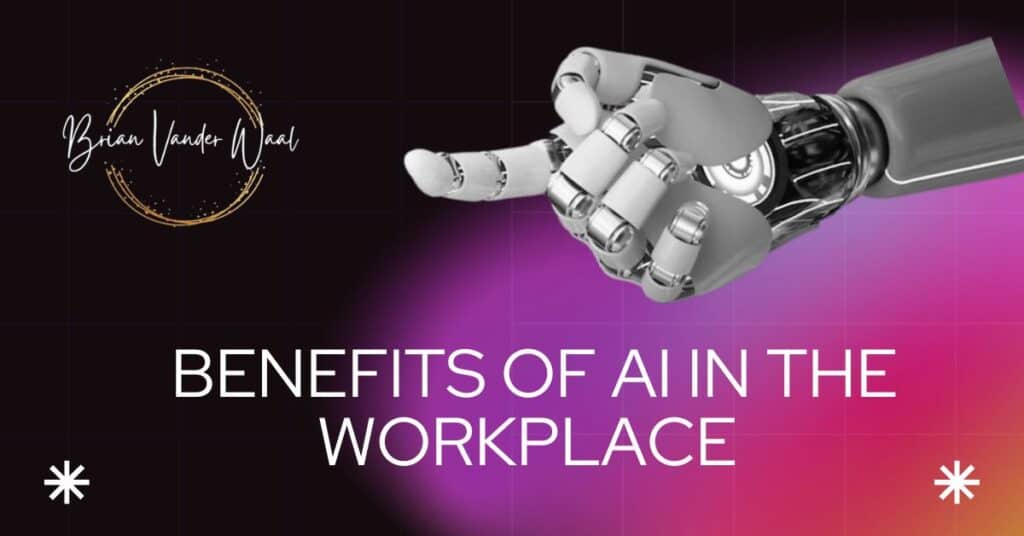
Organisations can harness its full spectrum of benefits by leveraging AI tools effectively. AI has significantly improved companies’ operations, leading to productivity metrics that reflect remarkable productivity growth. Below are some ways AI can benefit companies.
- Companies experience improved productivity and increased efficiency.
- AI can analyse huge amounts of data quickly.
- Artificial intelligence can automate routine tasks that often consume valuable employee time, allowing employees to focus on more strategic initiatives.
- With the ability to quickly analyse performance metrics, organisations can pinpoint areas needing improvement and implement solutions that help increase productivity across various departments.
- AI can assist teams in making informed decisions quickly, thus maximising productivity and efficiency across various departments.
- Generative AI can boost highly skilled teams by providing insights and suggestions for better outcomes.
- AI-driven chatbots and virtual assistants can manage customer inquiries, allowing staff to engage in creative problem-solving and innovation.
- By integrating AI solutions, organisations can create a more personalised work experience, increasing worker productivity through better employee engagement.
- AI-powered tools can analyse individual performance and preferences, allowing for tailored feedback and development opportunities.
- AI can automate routine communications, freeing time for employees to engage in meaningful discussions and projects.
While the benefits of AI in places of work are clear, they’re only part of the story. Organisations must go beyond implementation to harness AI’s power and focus on measurement.
Measuring the Impact of AI on Workplace Efficiency
Measuring the impact of AI on operational efficiency is essential for organisations looking to increase productivity. Companies can utilise various metrics and analytics tools to assess the effectiveness of AI implementations.
Key performance indicators (KPIs) such as time saved on routine tasks, increased output, and employee satisfaction levels provide valuable insights into whether AI tools are making an impact.
By conducting regular assessments, businesses can identify successful AI applications and areas for improvement, ensuring they maximise AI technologies’ potential.
Further, understanding the impact of AI on efficiency and productivity enables organisations to make informed decisions about future AI investments and strategies. As AI adoption continues to grow, the ability to measure its impact will be crucial for businesses aiming to stay competitive and drive sustained productivity gains.
However, as crucial as measuring AI’s impact is, it’s equally important to recognise that the path to successful AI implementation is often fraught with challenges. While the potential benefits are significant, organisations must navigate a complex challenges and considerations to realise these advantages fully.
Challenges and Considerations in AI Implementation
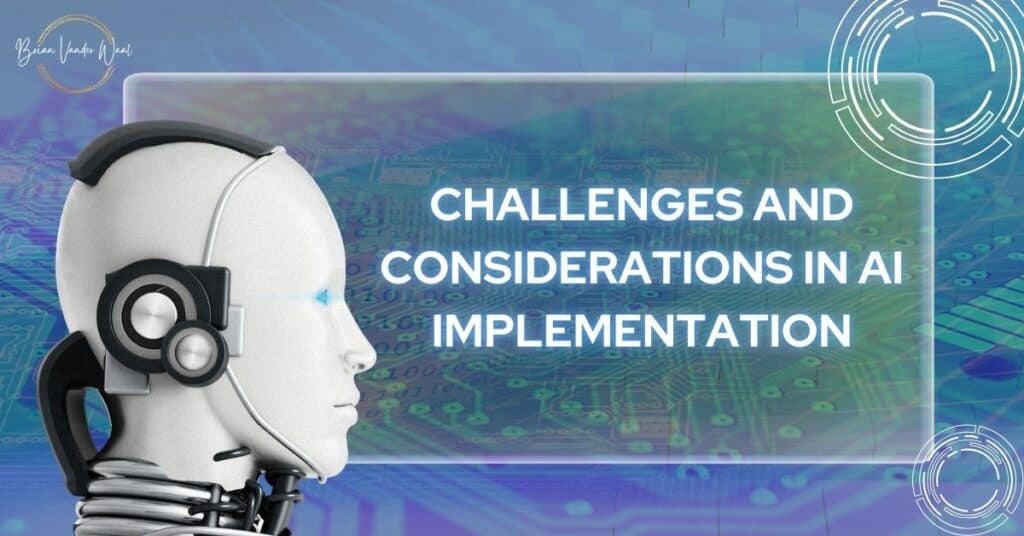
Implementing AI solutions presents several challenges organisations must manage to realise AI’s benefits fully.
- Integrating AI technologies within existing workflows often requires substantial adjustments in processes and employee roles.
- Resistance to change in the workforce can also hinder AI adoption, as employees may feel threatened by the automation of routine tasks.
- The cost of implementing AI solutions can be prohibitive, particularly for smaller businesses.
- Organisations collect large amounts of data to train AI algorithms and improve decision-making processes. However, handling sensitive employee and customer information raises significant privacy issues.
- Organisations must adhere to data protection laws and enforce robust security protocols to protect personal information from being compromised.
- Ethical considerations around AI bias and transparency must be addressed, as AI systems can inadvertently perpetuate existing inequalities if not carefully managed.
- Organisations must establish clear ethical guidelines for AI use and promote a culture of accountability in AI practices.
Organisations must carefully evaluate their AI strategies, ensuring they align with their objectives while addressing the potential hurdles associated with AI integration. By acknowledging these challenges, companies can devise effective strategies to overcome them and maximise the benefits of AI technologies.
Conclusion: How is AI Revolutionising Workplace Productivity?
AI’s impact on workplace productivity is profound and far-reaching. This article’s information, advice and examples highlight its transformative power across various industries.
Let’s revisit the key lessons from my experiences with AI tools:
- Data is king. AI tools are only as good as the data you feed it. Make sure your data collection and management are top-notch.
- Start with a clear problem to solve. Don’t implement AI just for its own sake.
- Prepare for change. AI will transform how you work. Make sure your team is ready and willing to adapt.
- Continuous learning is crucial. AI systems get better over time.
- Human expertise is still vital. AI tools provide insights, but human experts turn those insights into action.
With the right approach, AI can revolutionise productivity, simplify operations, and give your business a competitive edge.
Yet, the road to successful AI implementation isn’t without bumps. You must carefully navigate challenges such as employee resistance, data privacy and ethical considerations. Organisations need to strike a balance between technological advancement and human-centred approaches. It is vital to embrace these changes proactively.
How will you harness AI’s potential to transform your workplace and boost productivity?

